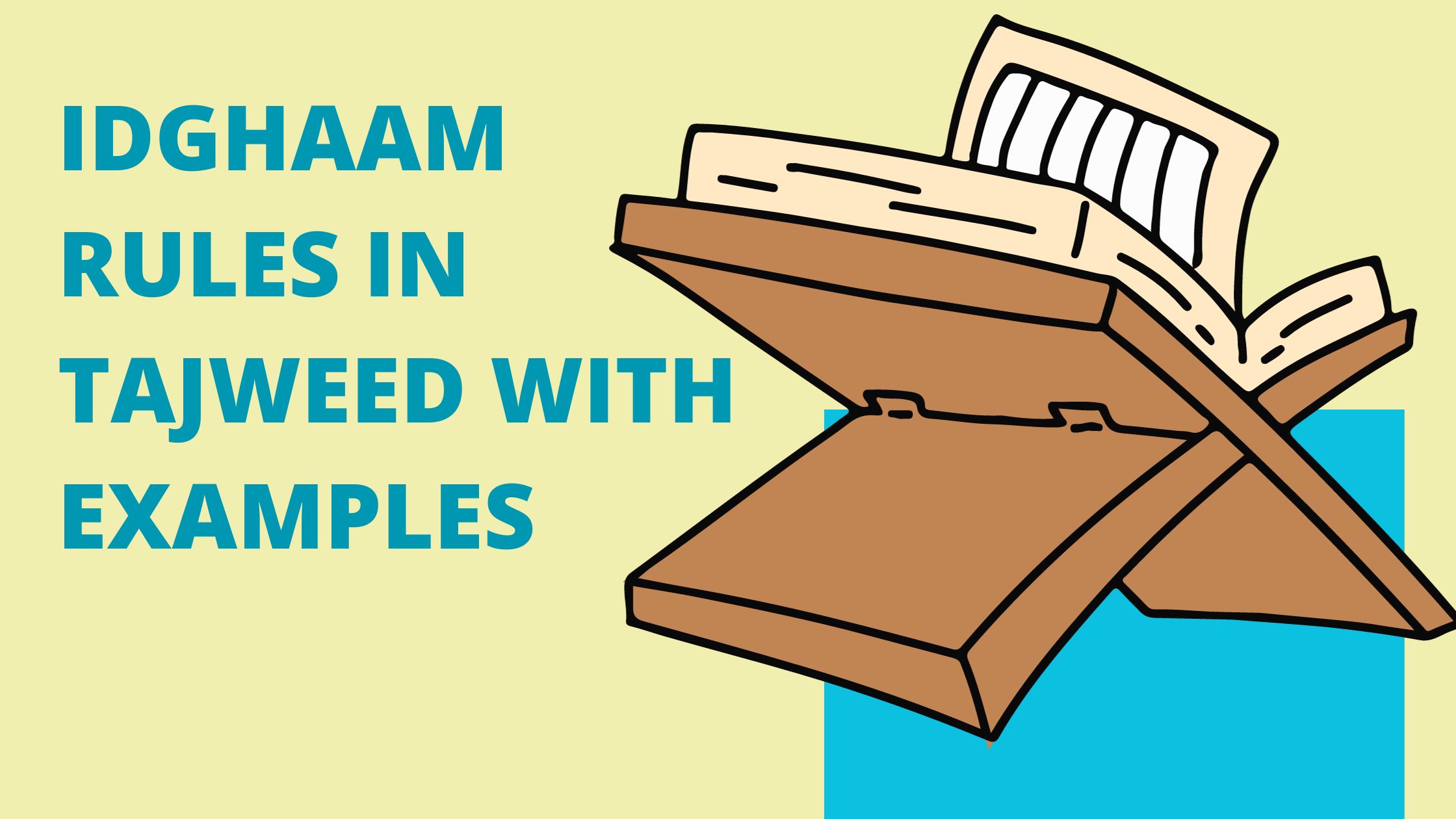In this article, we will be discussing the concept of the Idghaam, including its letters, rules, types, and examples found in the Quran.
Whether you are a beginner or have some knowledge of Tajweed, this guide will offer valuable insights into mastering this important aspect of reciting the Quran.
If you are interested in learning more about the beautiful art of reciting the Quran with correct pronunciation and melodious tones, let us dive in together and uncover the mysteries of Idghaam!
In this blog post, we will delve into the concept of Idgham in Tajweed, which is a crucial aspect of reciting the Quran correctly. We will begin by defining Idgham and then proceed to discuss its rules and various types. Additionally, to enhance our understanding of this concept, we will provide examples from the Quran.
Whether you are a beginner in learning Tajweed or someone looking to enhance your recitation skills, comprehending Idgham is vital for mastering this profound form of worship. So, without further ado, let us embark on this journey and deepen our knowledge of Idgham in Tajweed.
Table of Contents
What is Idgham in Tajweed?
The term Idgham in Tajweed refers to the merging or assimilation of certain letters when transitioning from one letter to another. It involves joining a non-vowel letter with a vowel letter in a way that the two letters become one sound in pronunciation. This merging is done to facilitate smoother and more seamless recitation of the Quran.
In more detail, Idgham happens when a nasal sound is followed by a non-nasal sound within the same word or at the end of one word and the beginning of the next. Instead of pronouncing both letters distinctly, the nasal sound is assimilated or merged into the following non-nasal sound. This merging creates a smoother flow in the recitation.
Definition of Idghaam:
Idghaam in Tajweed is the merging or assimilation of two letters during Quranic recitation, with the aim of creating a smoother and more fluid sound.
1. Linguistic Meaning of Idghaam in Arabic:
To understand the linguistic meaning of Idghaam in Arabic, we can look at its root verb, أدغم (adghama), which means to insert a rein into a horse’s mouth.
This analogy illustrates the concept of Idghaam in Tajweed, where a non-voweled letter is hidden or merged inside a voweled letter, similar to how a rein is hidden inside a horse’s mouth.
2. Definition of Idghaam in Tajweed:
Idghaam in Tajweed refers to the merging of two letters during Quranic recitation, creating a smoother and more fluid sound.
The term ‘Idghaam’ literally means “to merge” or “to add one thing into another.” It is an essential rule in Tajweed that governs the art of reciting the Quran.
3. Occurrence of Idghaam:
Idghaam in Tajweed occurs when a non-vowel (silent) letter is merged with a vowel, resulting in the two letters becoming one.
This merging typically happens when certain letters follow the Noon Sakinah or Tanween which are indicators of a nasal sound.
Purpose and Benefits of Idghaam:
The purpose of Idghaam in Tajweed is to ease the pronunciation and enhance the rhythm and melody of Quranic recitation.
By merging two letters, it creates a seamless connection between them, allowing for a smoother and more harmonious recitation. It helps maintain the flow and continuity of the recitation, avoiding any disruption or pause between the letters.
Understanding Noon Saakin and Tanween in Tajweed is crucial for individuals striving to improve their Tajweed abilities.
Idgham Letters in Tajweed
In Tajweed, Idgham refers to the merging or joining of two letters to create one sound. This rule applies when Noon Sakinah (the letter noon without any vowel signs) or Tanween (the nasal sound indicated by diacritical marks on top of the letter noon) are followed by specific Arabic letters.
These letters include ي (yaa), ر (ra), م (meem), ل (lam), و (waaw), and ن (noon). To help learners memorize the Idgham letters, they can be arranged into the word “يرْمَلُون” (yarmaloon) in Arabic. This provides a convenient mnemonic device for remembering the letters that trigger Idgham in Tajweed.
To fully understand these concepts and become proficient in the rules of Noon Saakin and Tanween in Tajweed, we recommend enrolling in Bayan Al-Quran Academy. Our experienced teachers will provide comprehensive lessons that cover all aspects of Tajweed rules.
In Tajweed, six specific letters are identified for the rule of Idghaam. These letters play a crucial role in merging the sounds when they follow Noon Sakinah or Tanween. Letters of Idghaam:
1. الرّاء (ر) – Raa:
When it follows Noon Sakinah or Tanween, the Noon sound merges into Raa.
2. الميم (م) – Meem:
The merging occurs with the Noon Sakinah or Tanween into Meem.
3. اللام (ل) – Lam:
Similar to Ra, when Lam follows Noon Sakinah or Tanween, the Noon sound merges into Lam.
4. الواو (و) – Waw:
The merging happens with the Noon Sakinah or Tanween into Waw.
5. النون (ن) – Noon:
When a Noon follows another Noon Sakinah or Tanween, the two Noons merge.
6. الياء (ي) – Ya:
The Ya letter merges with the preceding Noon Sakinah or Tanween.
The phrase يَرْمَلُون can be used as a mnemonic to remember these Idghaam letters. When one of these letters appears at the start of a word immediately following a word ending in Noon Sakinah or Tanween, the Noon sound merges into the following Idghaam letter.
Rules of Idgham in Tajweed:
In Tajweed, the rules of Idghaam involve merging the sound of Noon Sakinah or Tanween with the following letter. The emphasis is placed on the succeeding letter due to the presence of Shaddah.
1. Sukoon must be one of the letters of Idgham
The letter with the Sukoon must be one of the letters of Idgham, which are ي (ya’), و (waw), ر (ra’), ل (la’), م (meem), and ن (noon).
2. Noon Sakinah or Tanween followed by any of the Idghaam letters
If Noon Sakinah or Tanween is followed by any of the Idghaam letters (such as ر, م, ل, و, ن, or ي), the Noon Sakinah or Tanween is merged into the following letter.
3. Idgham occurs on the succeeding letter
The emphasis is placed on the succeeding letter, which is pronounced with an added emphasis due to the presence of Shaddah.
4. Idgham preceded with Noon Sakinah or Tanween
When Noon Sakinah or Tanween precedes the letters involved in Idghaam, the merging is pronounced with an emphasis on the merged sound.
5. Makharij Rulings:
The letter with the Sukoon must be followed by a letter with the same point of articulation (Makharij). For example, if the ن (noon) with Sukoon or Tanween is followed by a و (waw), both sounds will merge.
6. Shadda Rulings with Idgham
The letter with the Sukoon must not be a shadda letter. Shadda is a double-form letter, and when it appears after ن (noon) with Sukoon or Tanween, it does not participate in the merging process. Instead, it is pronounced separately.
7. Hamzah and Sukoon rulings:
The letter with the Sukoon must not be followed by a hamzah (glottal stop) or another Sukoon. Hamzah and Sukoon are not involved in the merging process and are pronounced separately.
Practice makes perfect when it comes to mastering Tajweed rules! Continue practicing and seeking guidance from qualified teachers who can assist you in refining your skills in proper Quranic recitation.
At Bayan Al-Quran, our online Quran classes for kids focus on Tajweed rules, including Idghaam, to ensure proper pronunciation and understanding. Join us today for a transformative learning experience!
Note: Read The Difference between Ikhfa, Idgham, Izhar, and Iqlab in Tajweed.
Enroll Your Child in the Top Noorani Qaida Course for Kids at Bayan Al-Quran Academy Today!
The best online Noorani Qaida course for kids can be found at Bayan Al-Quran Academy. This course is specifically designed to cater to the needs of young learners and aims to provide them with the essential Arabic skills required to properly recite the Quran.
The course focuses on teaching the alphabet, and words, and reading complete verses from the Quran, along with the basic Tajweed rules. The academy’s experienced tutors use phonetic sounds to ensure correct pronunciation and make learning enjoyable for children.
With Bayan Al-Quran Academy, your child can learn Noorani Qaida online and develop a strong foundation in Quranic Arabic with Tajweed.
Conclusion
To conclude, the Idghaam in Tajweed is an important aspect of proper Quranic recitation. It refers to the merging or blending of certain letters when they occur together in specific combinations.
There are several letters involved in Idghaam, including Raa, Meem, Lam, Waw, Noon, and Ya. Each letter follows its own set of rules for pronunciation and merging with other letters.
There are various types of Idghaam, such as with Ghunna, without a Ghunnah, Kamil, Naqis, Mutganis, Mutaqaribain, Mutamatsilain Sagheer, Mutamatsilain Kabir, and Mutamatsilain Mutlak.
If you want your child to excel in Arabic and Quran Tajweed from a young age, consider enrolling them in the top Noorani Qaida course for kids at Bayan Al-Quran Academy today!





















